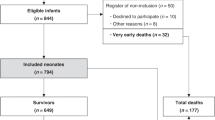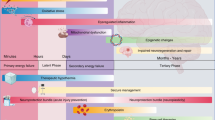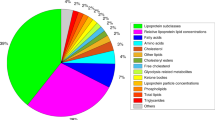Abstract
A period of secondary energy failure consisting of a decline in phosphocreatine/inorganic phosphate (PCr/Pi), a rise in brain lactate, and alkaline intracellular pH (pHi) has been described in infants with neonatal encephalopathy. Strategies that ameliorate this energy failure may be neuroprotective. We hypothesized that a neonatal rat brain slice model undergoes a progressive decline in energetics, which can be ameliorated with hypothermia or amiloride. Interleaved phosphorus (31P) and proton (1H) magnetic resonance (MR) spectra were obtained from 350 μm neonatal rat brain slices over 8 h in a bicarbonate buffer at 37°C and at 32°C in 7- and 14-d models. 31P MR spectra were obtained with amiloride in a bicarbonate-free buffer at 37°C in the 14-d model. Findings were similar in 7- and 14-d models. In the 14-d model, there was a Pi doublet structure corresponding to alkaline pHi values of 7.50 ± 0.02 and 7.21 ± 0.04. Compared with the stabilized baseline of 100, at 5 h PCr/Pi was 65 ± 6.3 and lactate/NAA was 187 ± 3 at 37°C, but PCr/Pi and lactate/NAA were not significantly different from baseline at 32°C. Nucleotide triphosphate (NTP)/phosphomonoester (PME) was 0.93 ± 0.23 at 37°C and 1.81 ± 0.21 at 32°C at 5 h. With amiloride exposure in the 14-d model, baseline pHi values were 7.25 ± 0.09 and 6.98 ± 0.02 and NTP/PME was 1.81 ± 0.05; these parameters were not significantly different at 5 h. Our interpretation of these findings is that the brain slice model underwent secondary energy failure, which was delayed with hypothermia or amiloride.
Similar content being viewed by others
Log in or create a free account to read this content
Gain free access to this article, as well as selected content from this journal and more on nature.com
or
Abbreviations
- 1H:
-
proton
- KHB:
-
Krebs Henseleit buffer
- MR:
-
magnetic resonance
- MRS:
-
magnetic resonance spectroscopy
- Na+/H+ transporter:
-
sodium/proton transporter
- NE:
-
neonatal encephalopathy
- NTP:
-
nucleotide triphosphate
- 31P:
-
phosphorus
- PCr:
-
phosphocreatine
- pHi:
-
intracellular pH
- Pi:
-
inorganic phosphate
- PME:
-
phosphomonoester
References
Grether JK, Nelson KB 1997 Maternal infection and cerebral palsy in infants of normal birth weight. JAMA 278: 207–211
Badawi N, Kurinczuk JJ, Keogh JM, Alessandri LM, O'Sullivan F, Burton PR, Pemberton PJ, Stanley FJ 1998 Antepartum risk factors for newborn encephalopathy: the Western Australian case-control study. BMJ 317: 1549–1553
Cowan F, Rutherford M, Groenendaal F, Eken P, Mercuri E, Bydder GM, Meiners LC, Dubowitz LM, de Vries LS 2003 Origin and timing of brain lesions in term infants with neonatal encephalopathy. Lancet 361: 736–742
Hope PL, Costello AM, Cady EB, Delpy DT, Tofts PS, Chu A, Hamilton PA, Reynolds EO, Wilkie DR 1984 Cerebral energy metabolism studied with phosphorus NMR spectroscopy in normal and birth-asphyxiated infants. Lancet 2: 366–370
Younkin DP, Delivoria-Papadopoulos M, Leonard JC, Subramanian VH, Eleff S, Leigh JS Jr, Chance B 1984 Unique aspects of human newborn cerebral metabolism evaluated with phosphorus nuclear magnetic resonance spectroscopy. Ann Neurol 16: 581–586
Laptook AR, Corbett RJ, Uauy R, Mize C, Mendelsohn D, Nunnally RL 1989 Use of 31P magnetic resonance spectroscopy to characterize evolving brain damage after perinatal asphyxia. Neurology 39: 709–712
Martin E, Buchli R, Ritter S, Schmid R, Largo RH, Boltshauser E, Fanconi S, Duc G, Rumpel H 1996 Diagnostic and prognostic value of cerebral 31P magnetic resonance spectroscopy in neonates with perinatal asphyxia. Pediatr Res 40: 749–758
Roth SC, Edwards AD, Cady EB, Delpy DT, Wyatt JS, Azzopardi D, Baudin J, Townsend J, Stewart AL, Reynolds EO 1992 Relation between cerebral oxidative metabolism following birth asphyxia and neurodevelopmental outcome and brain growth at one year. Dev Med Child Neurol 34: 285–295
Hanrahan JD, Cox IJ, Azzopardi D, Cowan FM, Sargentoni J, Bell JD, Bryant DJ, Edwards AD 1999 Relation between proton magnetic resonance spectroscopy within 18 hours of birth asphyxia and neurodevelopment at 1 year of age. Dev Med Child Neurol 41: 76–82
Lorek A, Takei Y, Cady EB, Wyatt JS, Penrice J, Edwards AD, Peebles D, Wylezinska M, Owen-Reece H, Kirkbride V, Cooper C, Aldridge RF, Roth SC, Brown G, Delpy DT, Reynolds EOR 1994 Delayed (‘secondary') cerebral energy failure after acute hypoxia-ischaemia in the newborn piglet: continuous 48-hour studies by 31phosphorus magnetic resonance spectroscopy. Pediatr Res 36: 699–706
Penrice J, Lorek A, Cady EB, Amess P, Wylezinska M, Cooper CE, D'Souza P, Brown GC, Kirkbride V, Edwards AD, Wyatt JS, Reynolds EO 1997 Proton magnetic resonance spectroscopy of the brain during acute hypoxia-ischemia and delayed cerebral energy failure in the newborn piglet. Pediatr Res 41: 795–802
Taylor DL, Edwards AD, Mehmet H 1999 Oxidative metabolism, apoptosis and perinatal brain injury. Brain Pathol 9: 93–117
Eicher DJ, Wagner CL, Katikaneni LP, Hulsey TC, Bass WT, Kaufman DA, Horgan MJ, Languani S, Bhatia JJ, Givelichian LM, Sankaran K, Yager JY 2005 Moderate hypothermia in neonatal encephalopathy: efficacy outcomes. Pediatr Neurol 32: 11–17
Gluckman PD, Wyatt JS, Azzopardi D, Ballard R, Edwards AD, Ferriero DM, Polin RA, Robertson CM, Thoresen M, Whitelaw A, Gunn AJ 2005 Selective head cooling with mild systemic hypothermia after neonatal encephalopathy: multicentre randomized trial. Lancet 365: 663–670
Shankatan S, Laptook A, Ehrenkranz R, Tyson J, McDonald S, Donavan E et al. 2005 Reduction in death or moderate/severe disability by whole body hypothermia for hypoxic-ischemic encephalopathy. Pediatr Res 57: 1548
Mabe H, Blomqvist P, Siesjo BK 1983 Intracellular pH in the brain following transient ischaemia. J Cereb Blood Flow Metab 3: 109–114
Masereel B, Pochet L, Laeckmann D 2003 An overview of inhibitors of Na(+)/H(+) exchanger. Eur J Med Chem 38: 547–545
Piper HM, Balser C, Ladilov YV, Schafer M, Siegmund B, Ruiz-Meana M, Garcia-Dorado D 1996 The role of Na+/H+ exchange in ischemia-reperfusion. Basic Res Cardiol 91: 191–202
Robertson NJ, Cowan FM, Cox IJ, Edwards AD 2002 Brain alkaline intracellular pH after neonatal encephalopathy. Ann Neurol 52: 732–742
Simon RP, Niro M, Gwinn R 1993 Brain acidosis induced by hypercarbic ventilation attenuates focal ischaemic injury. J Pharmacol Exp Ther 267: 1428–1431
Vannucci RC, Towfighi J, Bruchlacher RM, Vannucci SJ 2001 Effect of extreme hypercapnia on hypoxic-ischaemic brain damage in the immature rat. Pediatr Res 49: 799–803
Vornov JJ, Thomas AG, Jo D 1996 Protective effects of extracellular acidosis and blockade of sodium/hydrogen ion exchange during recovery from metabolic inhibition in neuronal tissue culture. J Neurochem 67: 2379–2389
Robertson NJ, Kuint J, Counsell SJ, Rutherford TA, Coutts GA, Cox IJ, Edwards AD 2000 Characterization of cerebral white matter damage in preterm infants using 1H and 31P magnetic resonance spectroscopy. J Cereb Blood Flow Metab 20: 1446–1456
LaManna JC, Griffith JK, Cordisco BR, Lin CW, Lust WD 1992 Intracellular pH in rat brain in vivo and in brain slices. Can J Physiol Pharmacol 70: S269–277
Lin CW, Kalaria RN, Kroon SN, Bae JY, Sayre LM, LaManna JC 1996 The amiloride-sensitive Na+/H+ exchange antiporter and control of intracellular pH in hippocampal brain slices. Brain Res 731: 108–113
McIlwain H, Buchel L, Cheshire JD 1951 The inorganic phosphate and phosphocreatine of brain especially during metabolism in vitro. J Biochem (Tokyo) 48: 12–20
Rolleston FS, Newsholme EA 1967 Control of glycolysis in cerebral cortex slices. Biochem J 104: 524–533
Deza L, Eidleberg E 1967 Development of cortical electrical activity in the rat. Exp Neurol 17: 425–438
Whittingham TS, Warman E, Assaf H, Sick TJ, LaManna JC 1989 Manipulating the intracellular environment of hippocampal slices: pH and high-energy phosphates. J Neurosci Methods 28: 83–91
Bachelard H, Cox DW, Feeney J, Morris P 1985 Nuclear magnetic resonance studies of carbohydrate metabolism in vivo. Biochem Soc Trans 13: 835–839
Taylor DJ, Bore PJ, Styles P, Gadian DG, Radda GK 1983 Bioenergetics of intact human muscle. A 31P nuclear magnetic resonance study. Molec Biol Med 1: 77–94
Kost GJ 1990 pH standardisation for phosphorus-31 magnetic resonance heart spectroscopy at different temperatures. Magn Reson Med 14: 496–506
Espanol MT, Litt L, Yang GY, Chang LH, Chan PH, James TL, Weinstein PR 1992 Tolerance of low intracellular pH during hypercapnia by rat cortical brain slices: A 31P/1H NMR study. J Neurochem 59: 1820–1828
Saugstad OD 1996 Mechanisms of tissue injury by oxygen radicals: implications for neonatal disease. Acta Paediatr 85: 1–4
Chiappa A, Makuuchi M, Zbar AP, Biella F, Bellomi M, Biffi R, Bertani E, Vezzoni A, Crosta C, Andreoni B 2003 Effects of the free radical scavenger dimethyl sulphoxide on experimental normothermic ischaemia of the liver. Dig Surg 20: 238–245
Kemp GJ 1997 Physiological constraints on changes in pH and phosphorus metabolite concentrations in ischemically exercising muscle: implications for metabolic control and for the interpretation of 31P-magnetic resonance spectroscopic studies. MAGMA 5: 231–241
Bachelard H, McIlwain H 1985 Biochemistry and the central nervous system. Churchill Livingstone, Edinburgh
Mehmet H, Yue X, Penrice J, Cady E, Wyatt JC, Sarraf C, Squier M, Edwards AD 1998 Relation of impaired energy metabolism to apoptosis and necrosis following transient cerebral hypoxia-ischaemia. Cell Death Differ 5: 321–329
Varon S, McIlwain H 1961 Fluid content and compartments in isolated cerebral tissues. J Neurochem 8: 262–275
Rolleston FS, Newsholme EA 1967 Control of glycolysis in cerebral cortex slices. Biochem J 104: 524–533
Tasker RC, Sahota SK, Williams SR 2000 Hypercarbia and mild hypothermia, only when not combined, improve postischaemic bioenergetic recovery in neonatal rat brain slices. J Cereb Blood Flow Metab 20: 612–619
Thoresen M, Penrice J, Lorek A, Cady EB, Wylezinska M, Kirkbride V, Cooper CE, Brown GC, Edwards AD, Wyatt JS 1995 Mild hypothermia after transient hypoxia-ischemia ameliorates delayed cerebral energy failure in the newborn piglet. Pediatr Res 37: 667–670
Amess PN, Penrice J, Cady EB, Lorek A, Wylezinska M, Cooper CE, D'Souza P, Tyszczuk L, Thoresen M, Edwards AD, Wyatt JS, Reynolds EO 1997 Mild hypothermia after severe transient hypoxia-ischemia reduces the delayed rise in cerebral lactate in the newborn piglet. Pediatr Res 41: 803–808
Busto R, Globus MY, Dietrich WD, Martinez E, Valdes I, Ginsberg MD 1989 Effect of mild hypothermia on ischemia-induced release of neurotransmitters and free fatty acids in rat brain. Stroke 20: 904–910
Thoresen M, Satas S, Puka-Sundvall M, Whitelaw A, Hallstrom A, Loberg EM, Ungerstedt U, Steen PA, Hagberg H 1997 Post-hypoxic hypothermia reduces cerebrocortical release of NO and excitotoxins. Neuroreport 8: 3359–3362
Chen Q, Chopp M, Bodzin G, Chen H 1993 Temperature modulation of cerebral depolarization during focal cerebral ischemia in rats: correlation with ischemic injury. J Cereb Blood Flow Metab 13: 389–394
Edwards AD, Yue X, Squier MV, Thoresen M, Cady EB, Penrice J, Cooper CE, Wyatt JS, Reynolds EO, Mehmet H 1995 Specific inhibition of apoptosis after cerebral hypoxia-ischaemia by moderate post-insult hypothermia. Biochem Biophys Res Commun 26: 1193–1199
Laptook AR, Corbett RJ, Sterett R, Garcia D, Tollefsbol G 1995 Quantitative relationship between brain temperature and energy utilization rate measured in vivo using 31P and 1H magnetic resonance spectroscopy. Pediatr Res 38: 919–925
Astrup J 1982 Energy-requiring cell functions in the ischemic brain. Their critical supply and possible inhibition in protective therapy. J Neurosurg 56: 482–497
Siesjo BK, Bengtsson F 1989 Calcium fluxes, calcium antagonists, and calcium-related pathology in brain ischemia, hypoglycemia, and spreading depression: a unifying hypothesis. J Cereb Blood Flow Metab 9: 127–40
Traynelis SF, Cull-Candy SG 1990 Proton inhibition of N-methyl-d-aspartate receptors in cerebellar neurons. Nature 345: 347–350
Giffard RG, Weiss JH, Choi DW 1992 Extracellular alkalinity exacerbates injury of cultured cortical neurons. Stroke 23: 1817–1821
Mellgren RL 1987 Calcium dependent proteases: an enzyme system active at cellular membranes?. FASEB J 1: 110–115
Phillis JW, Ren J, O'Regan MH 2000 Inhibition of Na(+)/H(+) exchange by 5-(N-ethyl-N-isopropyl)-amiloride reduces free fatty acid efflux from the ischemic reperfused rat cerebral cortex. Brain Res 884: 155–162
Khaled AR, Kim K, Hofmeister R, Muegge K, Durum SK 1999 Withdrawal of IL-7 induces Bax translocation from cytosol to mitochondria through a rise in pH. Proc Natl Acad Sci USA 96: 14476–14481
Khaled AR, Reynolds DA, Young HA, Thompson CB, Muegge K, Durum SK 2001 Interleukin-3 withdrawal induces an early increase in mitochondrial membrane potential unrelated to the Bcl-2 family. Roles of intracellular pH, ADP transport and FOF1-ATPase. J Biol Chem 276: 6453–6462
Lemasters JJ, Nieminen AL, Qian T, Trost LC, Herman B 1997 The mitochondrial permeability transition in toxic, hypoxic and reperfusion injury. Mol Cell Biochem 174: 159–165
Yamamoto S, Matsumoto Y, Suzuki Y, Tsuboi T, Terakawa S, Ohashi N, Umemura K 2003 An Na+/H+ exchanger inhibitor suppresses cellular swelling and neuronal death induced by glutamate in cultured cortical neurons. Acta Neurochir Suppl 86: 223–226
Manev H, Bertolino M, DeErausquin G 1990 Amiloride blocks glutamate-operated cationic channels and protects neurons in culture from glutamate-induced death. Neuropharmacology 29: 1103–1110
Author information
Authors and Affiliations
Corresponding author
Additional information
Supported by the Higher Education Funding Council for England, Imperial College London, Philips Medical Systems, and JEOL (UK) Ltd., which funded the 500 MHz magnetic resonance spectroscopy facility under the Joint Research Equipment Initiative.
Rights and permissions
About this article
Cite this article
Robertson, N., Bhakoo, K., Puri, B. et al. Hypothermia and Amiloride Preserve Energetics in a Neonatal Brain Slice Model. Pediatr Res 58, 288–296 (2005). https://doi.org/10.1203/01.PDR.0000170899.90479.1E
Received:
Accepted:
Issue date:
DOI: https://doi.org/10.1203/01.PDR.0000170899.90479.1E
This article is cited by
-
Na+/H+ Exchangers and Intracellular pH in Perinatal Brain Injury
Translational Stroke Research (2014)
-
S100B Secretion in Acute Brain Slices: Modulation by Extracellular Levels of Ca2+ and K+
Neurochemical Research (2009)



